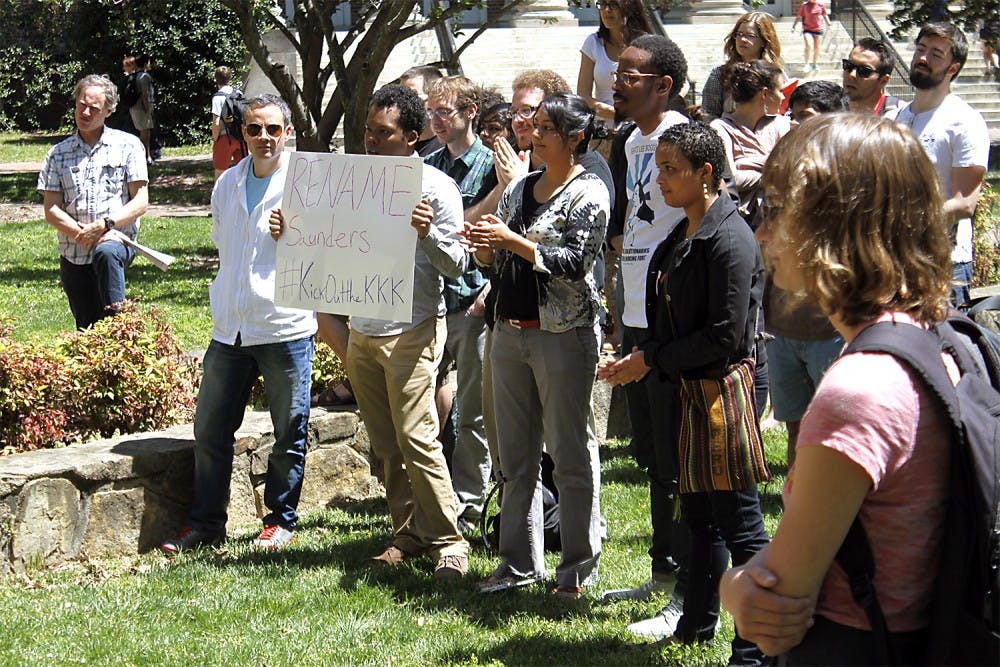The mantra for the movement is “Kicking out the KKK.” Blanche Brown, an organizer with the campaign, said the alliterative slogan embodies the crux of the campaign.
“We’re asking that a space be made safe and comfortable for all students,” she said.
UNC opened its doors to students in 1795 and a large portion of the campus landscape reflects the racial tensions that span the nation’s history, according to University historian Cecelia Moore.
And because of its flagship status, UNC educated many state and national leaders, like Saunders.
“This physical space reflects much of the history of the country,” Moore said. “We have not done enough as a country to acknowledge the truly troubled parts of our history. And that, specifically, is how we have treated non-white people.”
Saunders, who graduated from UNC in 1854, lead the North Carolina KKK during the late 1860s when the Klan embarked on a terror campaign intended to upend Reconstruction. He also served as N.C. Secretary of State and as a University trustee from 1874 until 1891.
Willie Wright, a doctoral candidate in the department of geography, said campus infrastructures are more than what they appear to students.
“They aren’t just places where we go to study English or social science,” he said. “They’re spaces that are named after individuals who perpetuated certain types of domination, particularly racial domination.”
And Saunders Hall isn’t the only campus building with a conflicted racial past. The Silent Sam memorial, Aycock Residence Hall, Hamilton Hall and Daniels Student Stores have all been questioned for their associations with white supremacist leaders or ideals.
Moore said the physical landscape of the University is not in tune with current cultural values.
Taffye Clayton, UNC’s vice provost for diversity and multicultural affairs, said cultivating an inclusive campus climate is important at UNC.
“What we know as diversity and inclusion practitioners is that organizations and leaders must work consistently to integrate the principles of equity, diversity and inclusion into the fabric,” she said.
To get the day's news and headlines in your inbox each morning, sign up for our email newsletters.
But student Parker Martin, a co-founder of the UNC Minority Experience project, said the University has a tendency to paint a perfect picture of diversity when, in reality, minorities may have a different experience at UNC than other students.
The project posted a video on YouTube detailing the experiences of black UNC students, as well as a brief commentary on how minority students perceive certain campus buildings.
In a 2002 paper, former UNC graduate student and activist Yonni Chapman said one black student became physically sick when she had to attend class in Saunders Hall after learning the building’s history.
Mariah Monsanto, a UNC senior, said she believes there should be education on these structures.
“I want people to know the history of UNC. I want people to know about how their English building was funded by a person who terrorized black people because he just didn’t like them,” she said.
New take on an old issue
This isn’t the first time students have challenged UNC’s political landscape.
From 2011 to 2013, The Real Silent Sam Coalition called for a plaque to contextualize Silent Sam within the white supremacy movement of the 1910s.
The committee asked for the plaque to reference the dedication speech given by Julian Carr that referred to its erection as “a win for the Anglo-Saxon race.”
But, former Chancellor Holden Thorp backed out and instead suggested that it be placed in front of the Unsung Founders monument. This prompted The Real Silent Sam to take a new approach.
Brown said renaming Saunders is a winnable goal because the Board of Trustees has the power to rename buildings. The case to rename Saunders will be presented at the board’s May 21 meeting.
“It’s less divisive than dealing with Silent Sam. We have the chance to win,” she said.
Lowry Caudill, chairman of the Board of Trustees, said the board is open to student input, but will have to abide by the University's policy on renaming buildings.
“The Board of Trustees welcomes input from students on this issue. We encourage them to share their research and thoughts with us," he said in an email. "I know Vice-Chair Alston Gardner has had conversations with students on this topic and we look forward to hearing from them. It's important to note that the University has a policy on renaming campus facilities, which would be our guideline in any such conversation.”
The policy states that a building may be renamed if an honoree's reputation changes significantly since the time of dedication, but historical context at the time of naming must be considered.
Wright said renaming the building and placing a plaque is not an end, but a means for change.
“We don’t just want for the building to be renamed and then that’s it. (It’s) a step in the right direction toward addressing these racial wounds that are open and bare.”
university@dailytarheel.com




